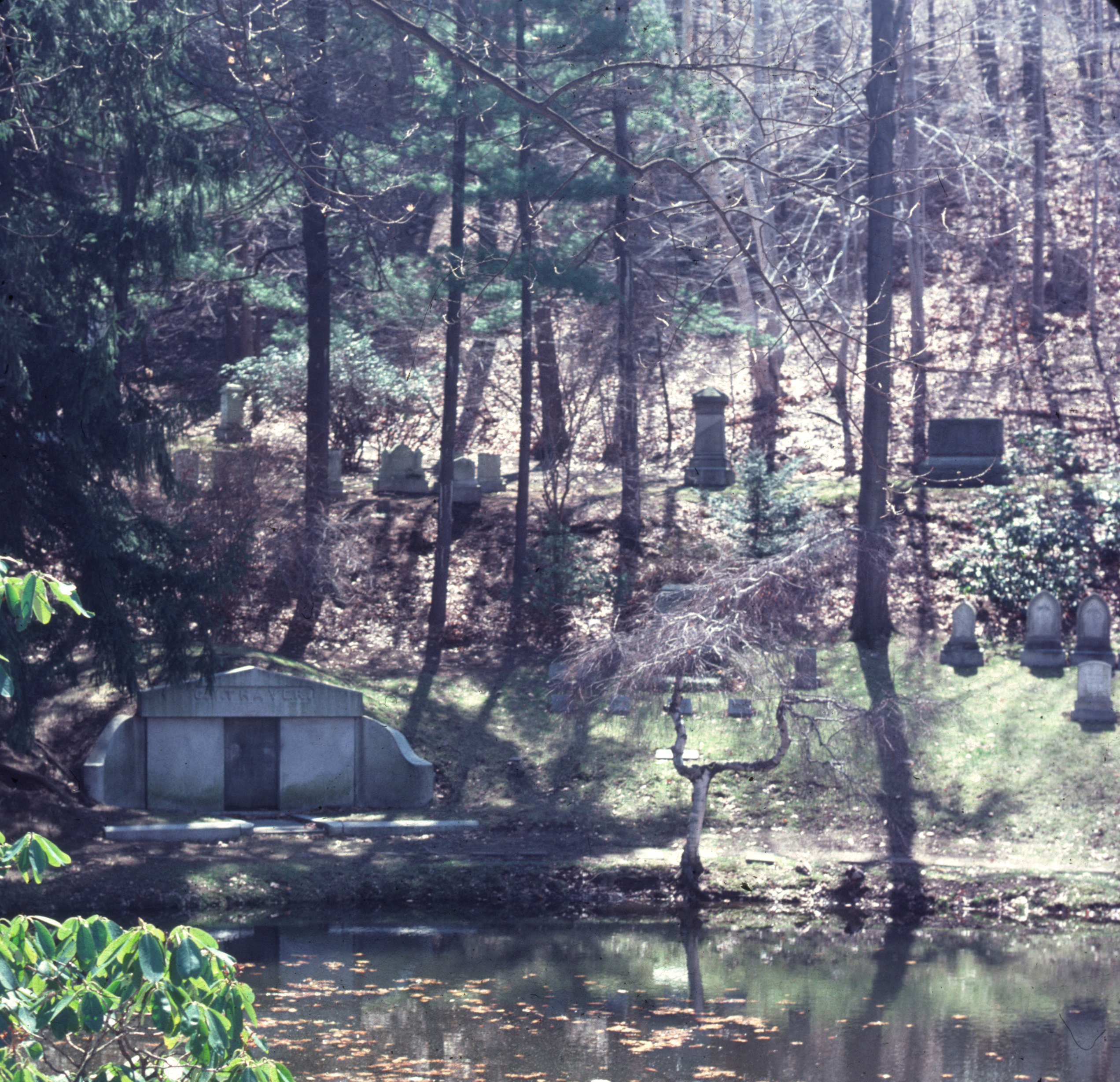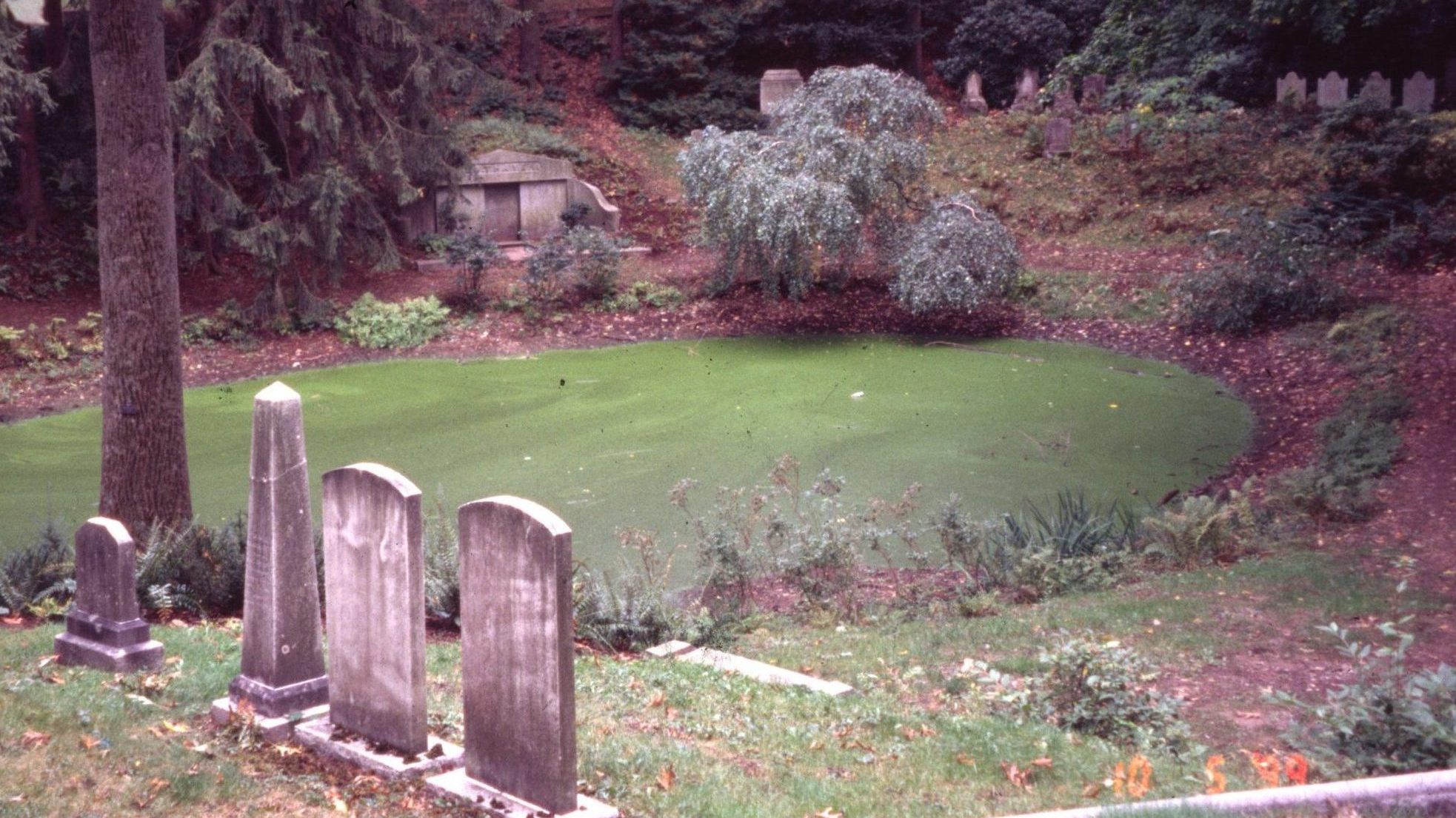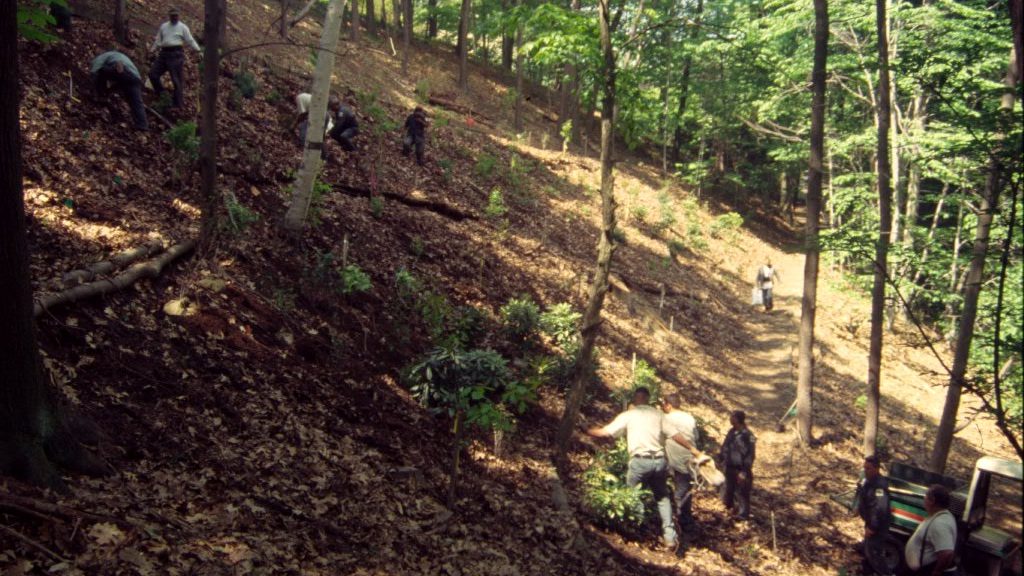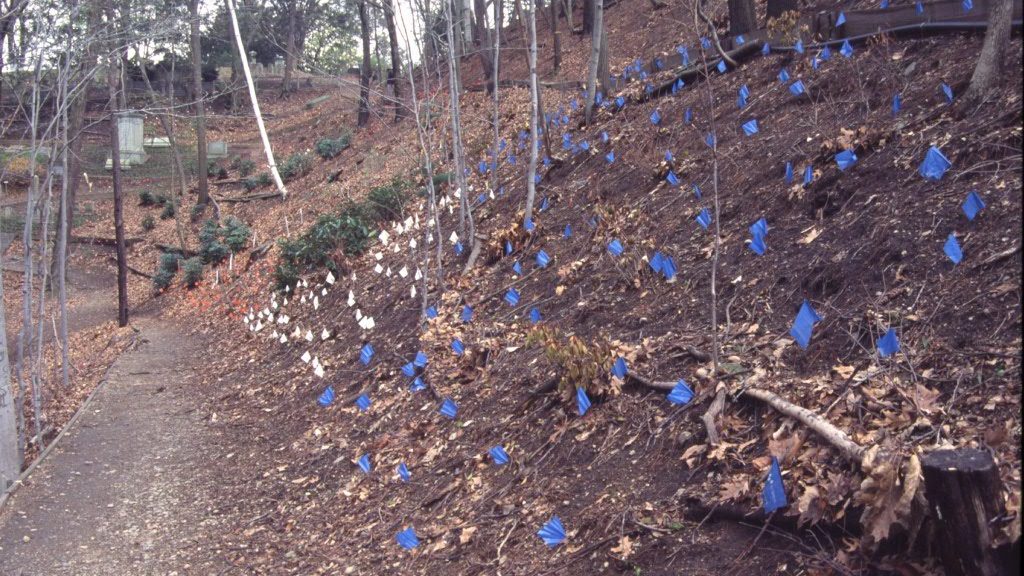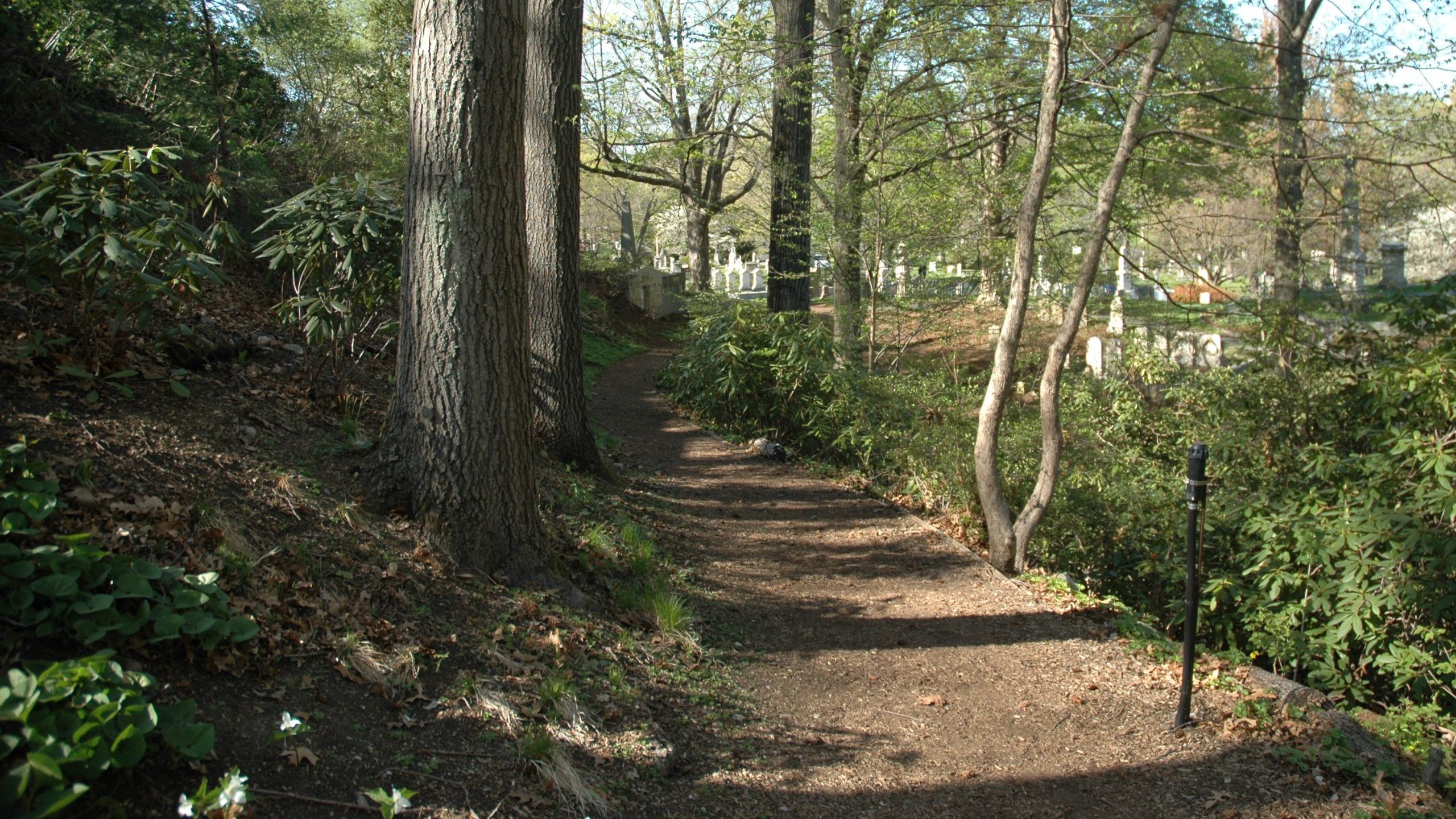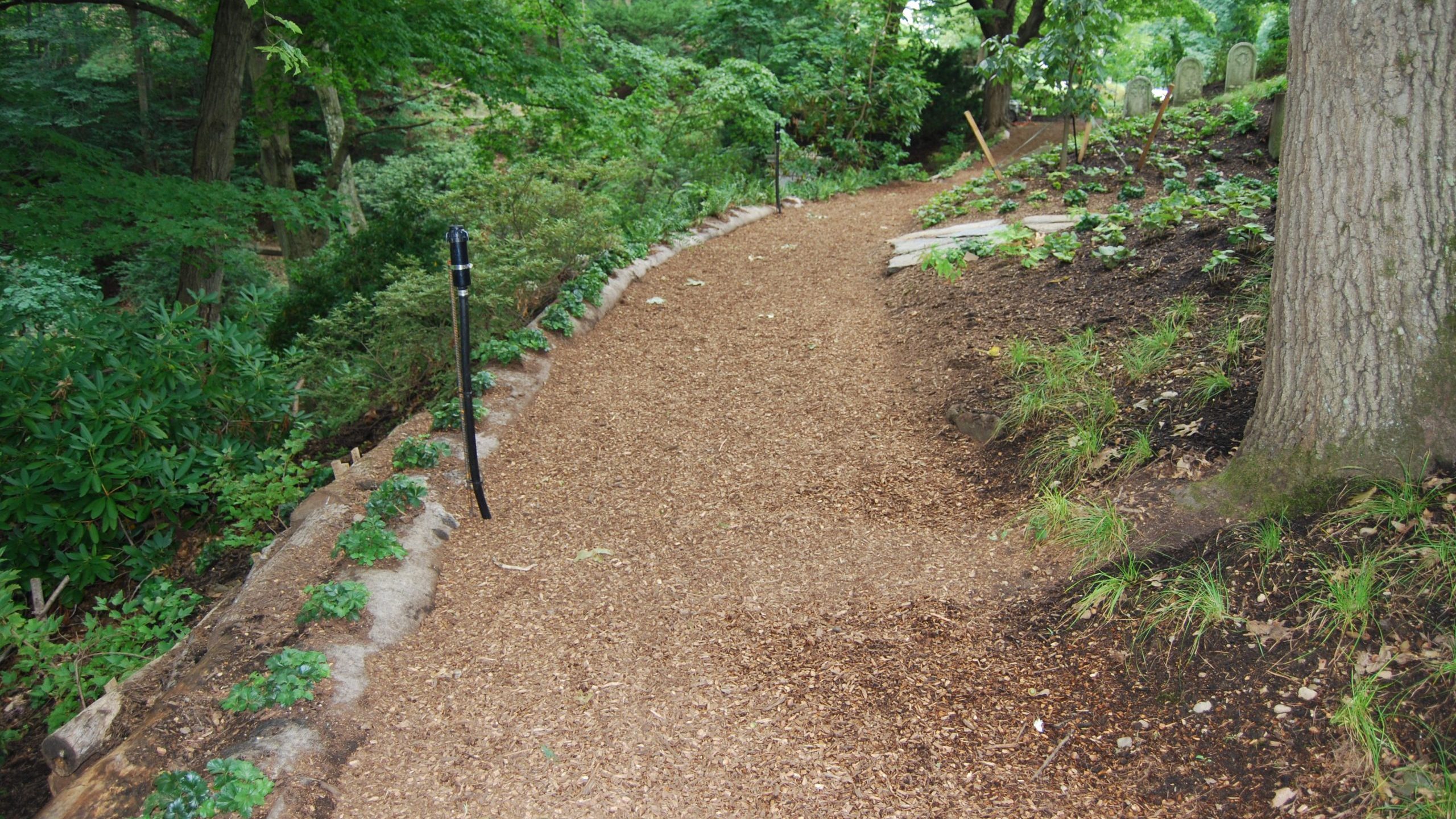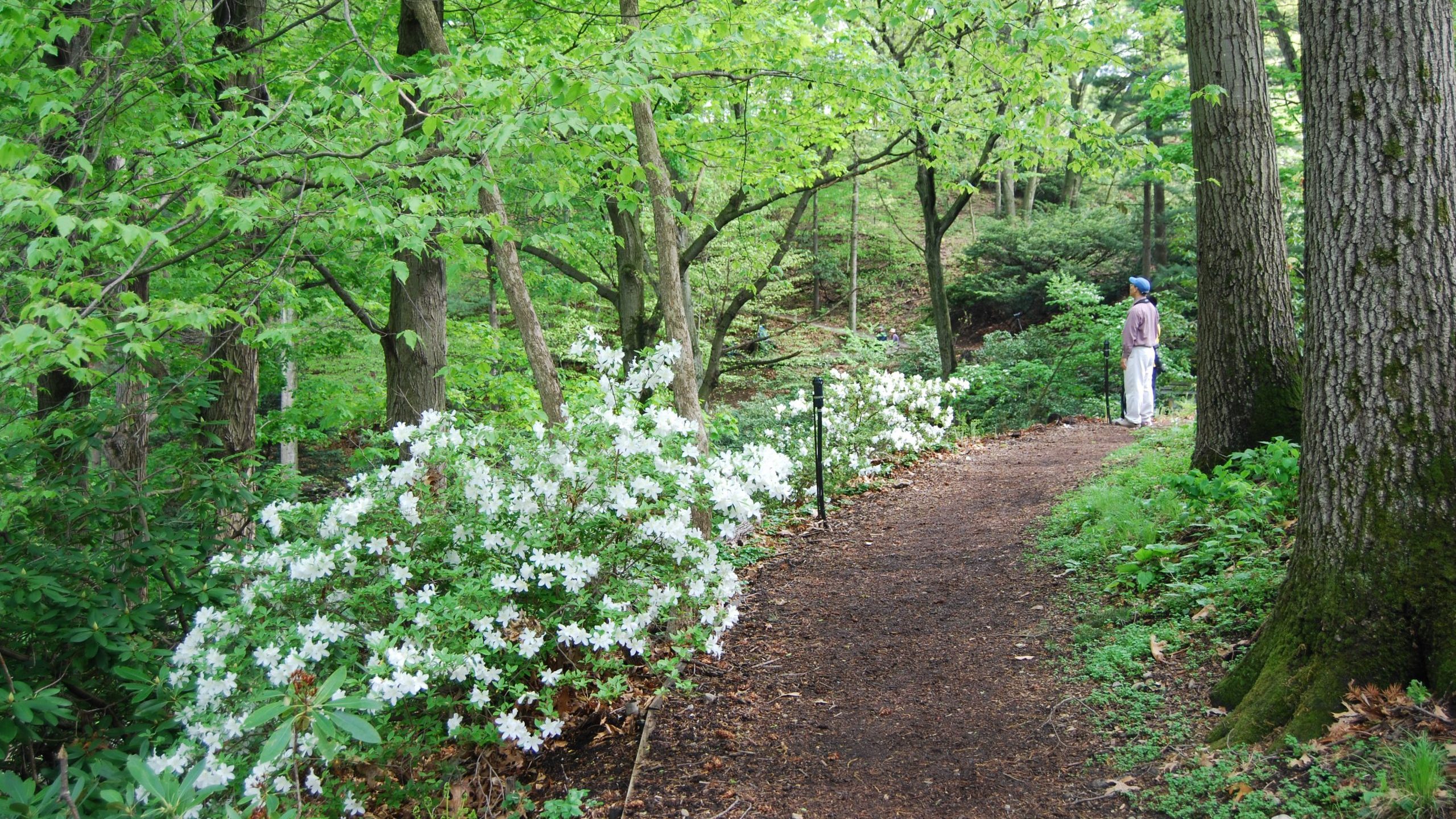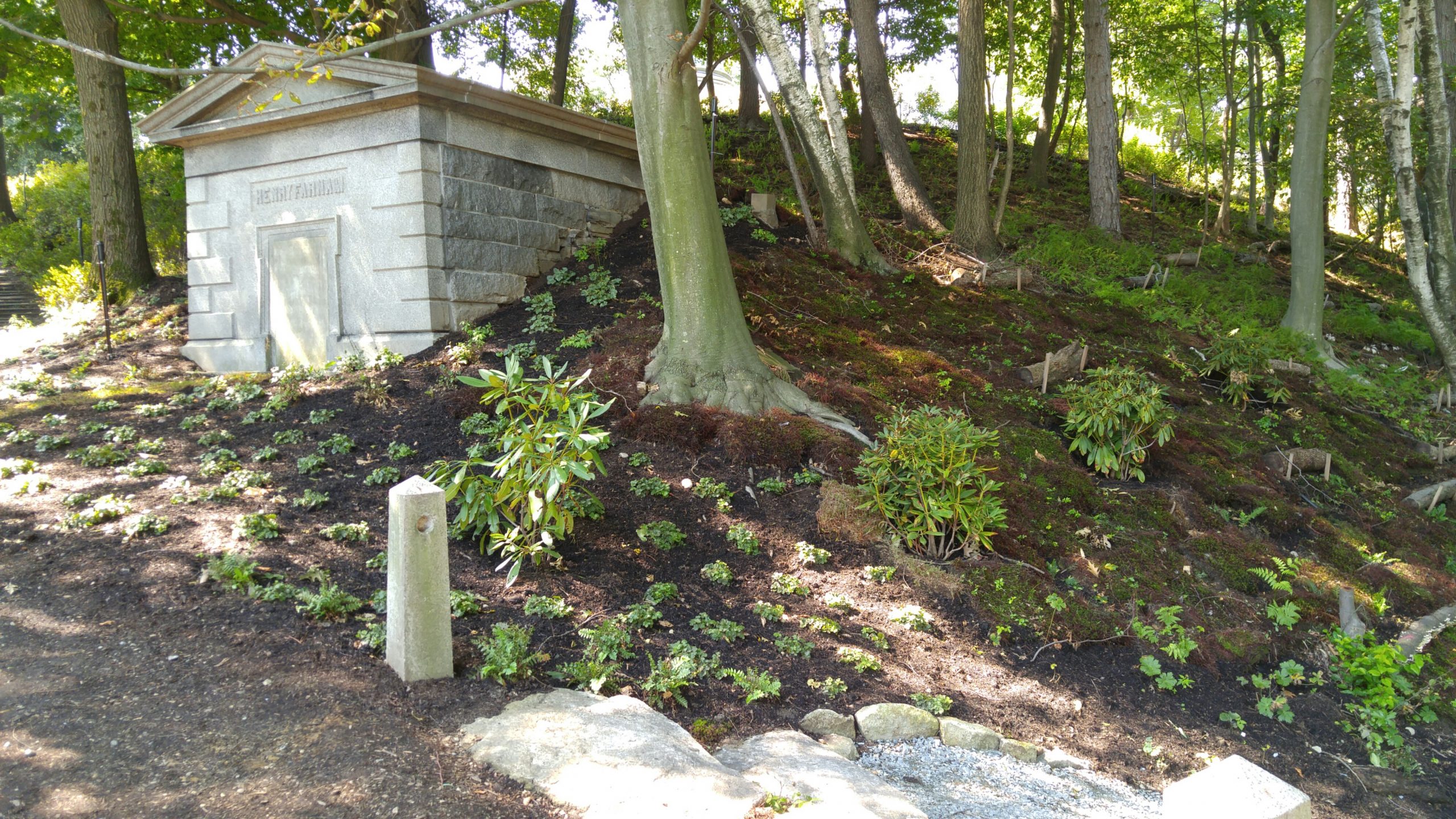Training a New Generation: Mount Auburn’s Horticulture Apprenticeship, 2020 Edition
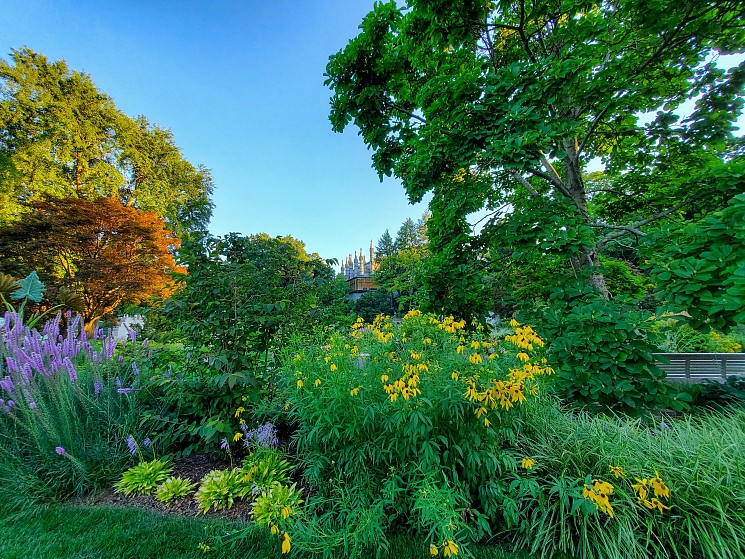
Anna Moir, Grants & Communications Manager
Keeping a landscape like Mount Auburn beautiful and well-maintained does not happen without a skilled team of horticulture professionals. No matter the season, our staff are always putting their expertise to use figuring out the best ways to design, plant, and maintain the Cemetery with both aesthetics and sustainability in mind. We have therefore been highly concerned by recent trends of declining numbers of specialized training programs, especially at the university level, and fewer young professionals entering the field. Our response since 2014 has been to offer our own paid apprenticeship programs, supporting and training talented students and recent graduates seeking careers in public horticulture. Thanks to a group of generous donors, we have been able to expand the program up through to today.
From seasonal internships to year-long immersive experiences, our programs provide intensive practical experience across the different specialties within our Horticulture Department. This has been mutually-beneficial as our participants gain expertise in multiple aspects of our complex horticulture and landscape operations, while also bringing talent, enthusiasm, and fresh perspectives as they support our staff on their projects.
While the Covid-19 pandemic forced many changes to our workflow to ensure everyone’s safety, we were lucky to still be able to host two participants: Alex Wolfe, a recent graduate who had originally started as the 2018-2019 apprentice but extended to a second year, and Katelyn McVay, a student in the class of 2022 at the University of Wisconsin-Madison who worked with us for the summer. As they get ready for a new semester and new opportunities, Alex and Katelyn sat down to reflect on their time here, and how it’s shaped them moving forward.
Alex Wolfe
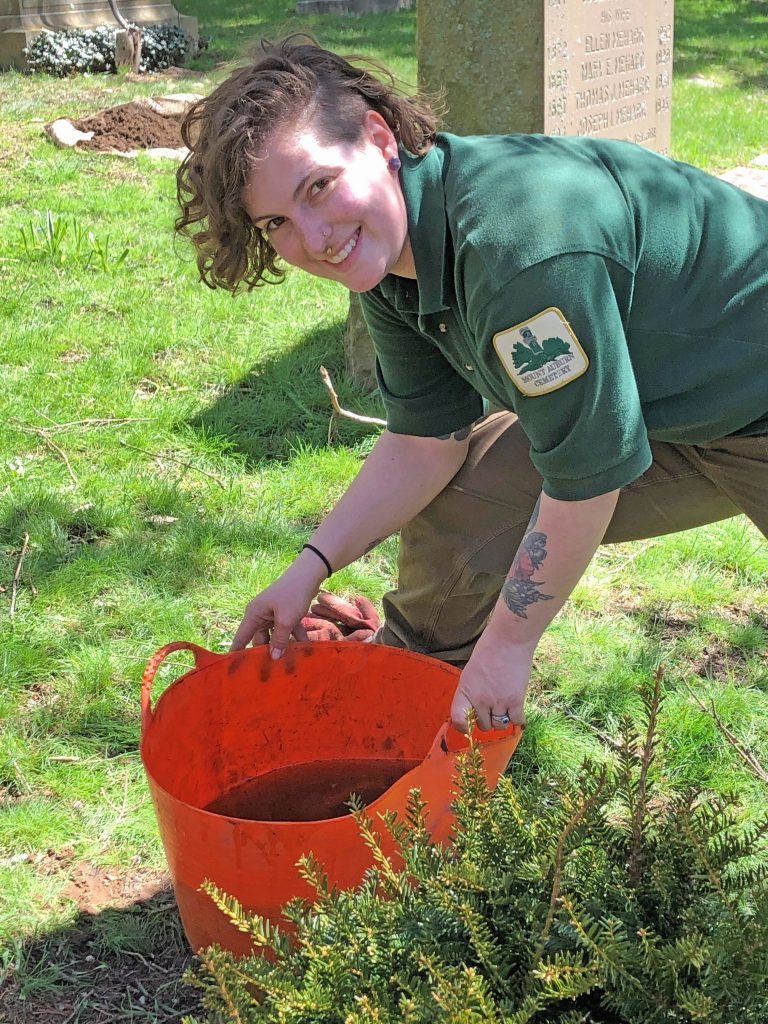
What brought her to Mount Auburn: I had worked in the field of horticulture for a bit in landscaping and greenhouse work, but wanted to learn more about some other sectors of horticulture. I saw that Mount Auburn had a rotating position where you get a taste of each of the departments in a year’s time. So I thought it would be a wonderful opportunity to get a better idea of what I would like to specialize in moving forward.
Favorite experiences: I think my favorite projects and highlights of my time here have been when I’m involved in planting projects. The main project I worked on last year and am involved in again this year are plantings in Consecration Dell and the North Dell Meadows. It was a great leadership opportunity and learning experience working with a contractor and using an architectural planting plan. I also loved that the focus of that area involves the use of native plants.
Learning new skills: Since beginning work here, my plant identification skills have exponentially grown, and I have obtained my Massachusetts Certified Horticulturist certification. My favorite department that I worked in was Plant Records. I’ve gained a good bit of taxonomic knowledge, experience working with a database, and exposure to GIS work.
Favorite spot at Mount Auburn: My favorite place is easily the Dell. I loved working on projects for this area, and love that it’s focused on habitat restoration and planting natives.
Future plans: Working with native plants in the Dell got me thinking more about the ecological side of things and working in plant records with taxonomy really sparked my interest in systematics and evolution. This fall I am starting my Master’s in Environmental Studies with a concentration in Conservation Biology at Antioch University New England. I hope to carry out work with the overall goal of plant conservation, in whatever capacity that may be.
Katelyn McVay
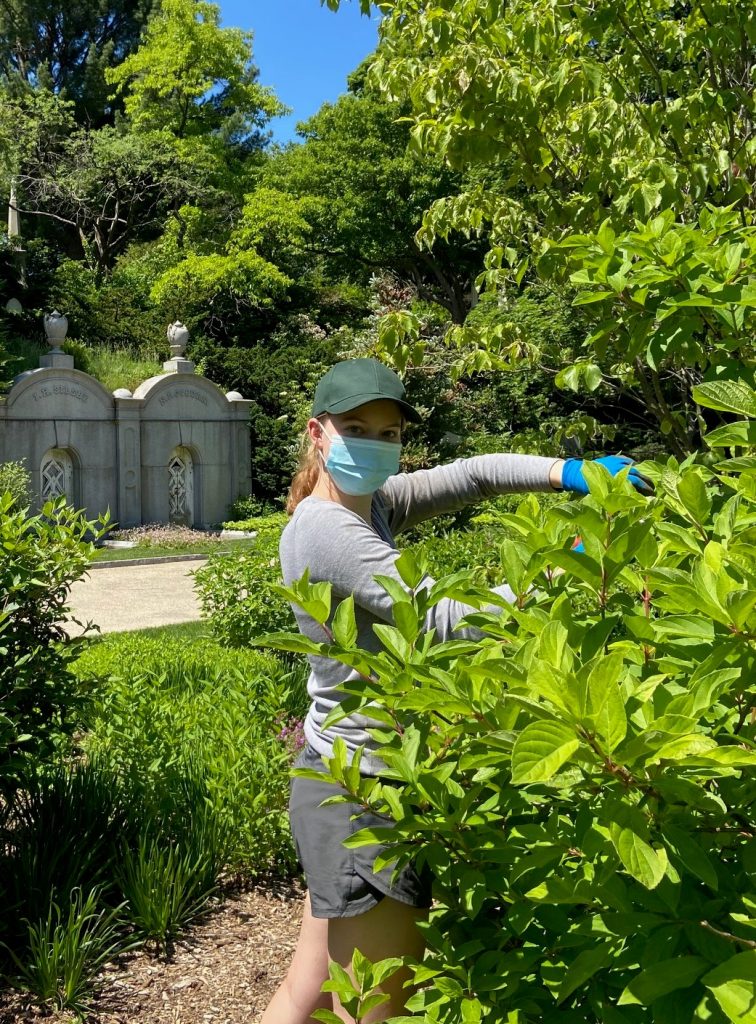
What brought her to Mount Auburn: Prior to applying here, Mount Auburn was my favorite natural space to visit while in Boston. I loved how Mount Auburn combined a rich history of landscapes and architecture with beautiful formal and natural gardens. I was extremely excited when I found out about the internship, and I was definitely drawn to the program due to the great opportunities, staff, and landscapes here.
Favorite experiences: I would have to say that one of my favorite projects that I worked on this summer was the garden in front of Story Chapel. My team and I planted everything in that area during my first week on the job, and it was a really exciting introduction to my position here. It was amazing to see how landscape architecture and design and horticulture came together to create something so beautiful and eye-catching in the front part of Mount Auburn.
Learning new skills: During this summer, besides working on the horticulture team, I also spent some time working at the greenhouse. While working there, I was introduced to a variety of plant propagation techniques. Prior to this experience, I didn’t fully understand how interesting and creative plant propagation could be. This learning experience at the greenhouse taught me how cool plants can be and skills that I’ll be able to use on my own plants and in my classes.
Favorite spot at Mount Auburn: My favorite place at Mount Auburn has to be Willow Pond. The scenery around that area is so peaceful, and it’s a place where I often found myself connecting with nature the most. Particularly, I really admire the tree selection and placement around Willow Pond and the sculpture and seating area on top of the hill.
Future plans: I plan to hopefully pursue a graduate degree in the plant sciences or in landscape architecture. This summer really helped me to discover my passion for plants and landscapes, and the professional and personal skills I have learned over the summer have reinforced my academic and career goals. I had such an amazing time here, and I’m so fortunate that Mount Auburn allowed me to pursue my passions and taught me how to apply the skills I learn in the classroom to the real world. For more information, please contact Jenny Gilbert at jgilbert@mountauburn.org
Consecration Dell
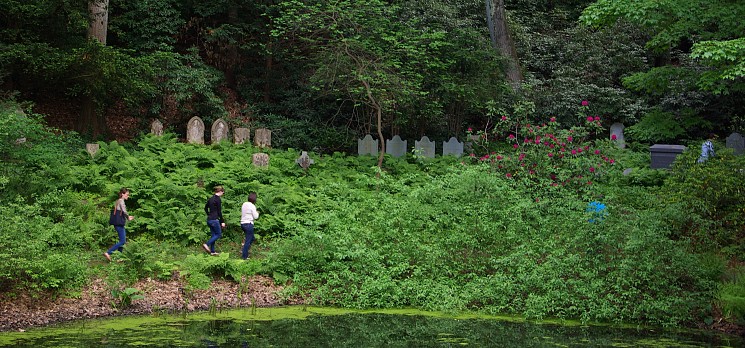
The Heart of Mount Auburn
Of all the many spots within Mount Auburn, Consecration Dell has a special allure. Here, 1,600 feet from the Cemetery’s entrance, you can imagine history taking place, marvel at the beauty of nature, and find solace from the cares of the world in a woodland oasis.
Hidden behind the steep slopes that enclose it, the Dell is a 4.2-acre natural valley with a small vernal pool in its center. In striking contrast to the Cemetery’s otherwise manicured landscape, the Dell is reminiscent of the New England forest. Native woodland trees, shrubs, perennials, and groundcovers provide year-round interest and provide essential food and shelter for resident and migratory wildlife.
The Dell embodies all that is magical, rejuvenating, and special about Mount Auburn. Visit in the spring to experience the Dell in peak bloom with a chorus of birds providing a natural soundtrack. Retreat beneath its dense shade on a warm summer day to discover its quiet tranquility. In the fall, take in its jewel-toned colors and see the Cemetery as its earliest visitors might have.
No matter when you visit Consecration Dell, you will find the comfort and solace of nature just as Mount Auburn’s founders intended.
The world rolls round,–mistrust it not,–
Ralph Waldo Emerson, “May-Day”
Befalls again what once befell;
All things return, both sphere and mote,
And I shall hear my bluebird’s note,
And dream the dream of Auburn dell.
WOODLAND RESTORATION
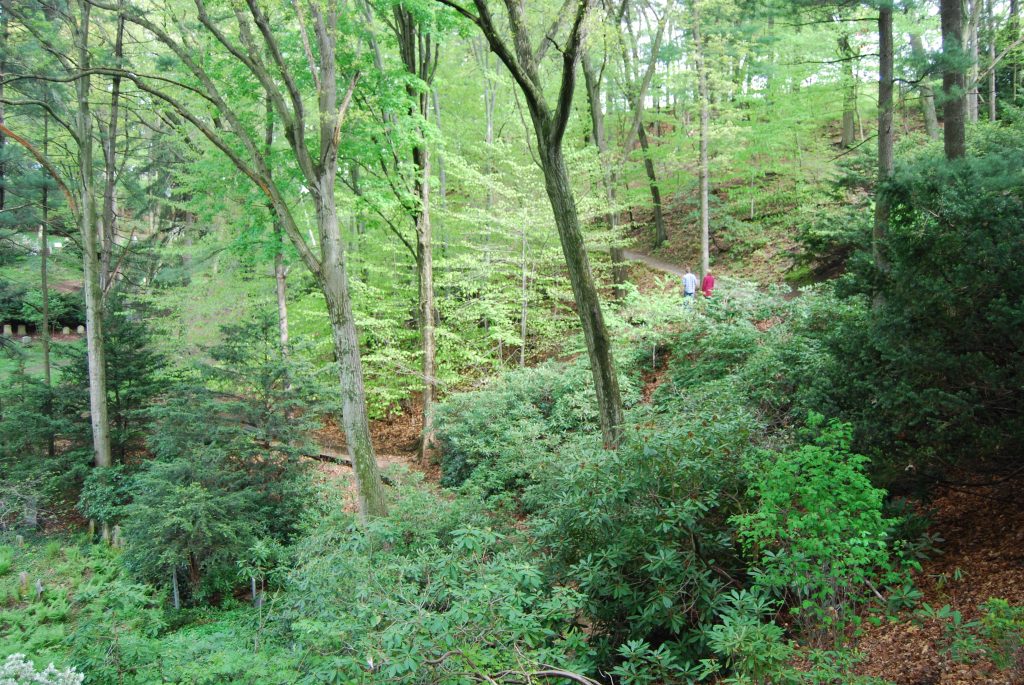
In 1997, the Cemetery began an ambitious project to restore Consecration Dell as a naturalistic woodland. With time and after much care, the Dell again reflects the earliest era of Mount Auburn’s history. This project, perhaps more than any other, symbolizes Mount Auburn’s long commitment to environmental stewardship.
PLANTS
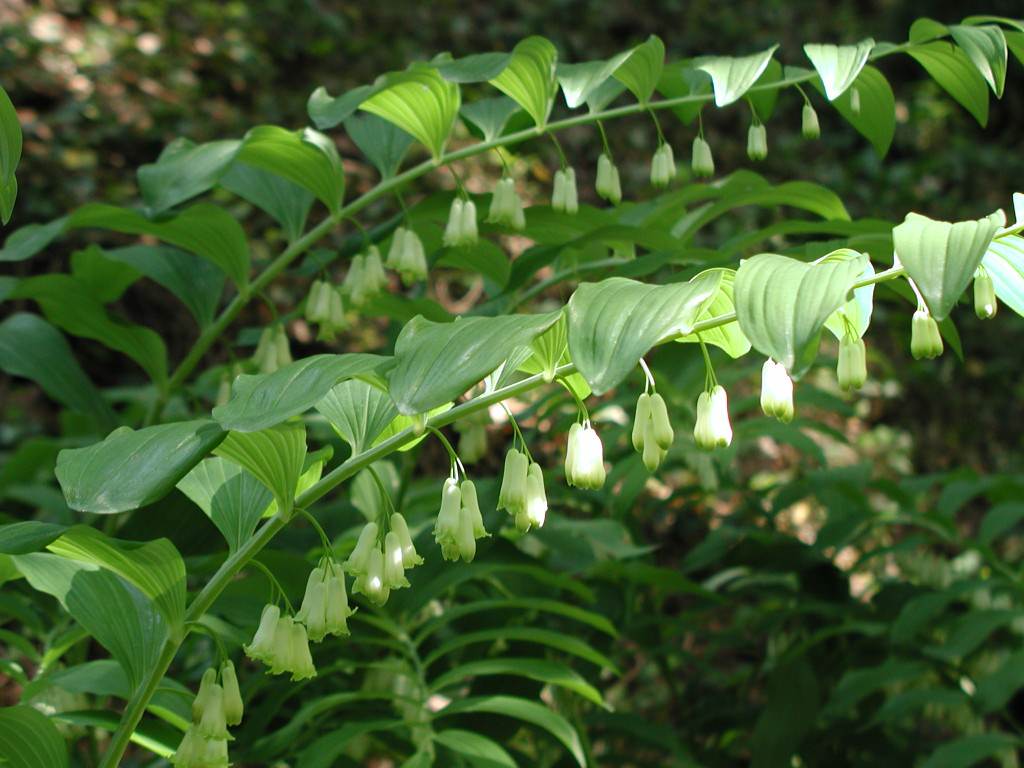
Woodland plants, native to the New England forest, dominate the Consecration Dell landscape. The shade-tolerant plants that thrive in this area have been carefully selected for their beauty and ability to provide beneficial habitat.
VISIT CONSECRATION DELL
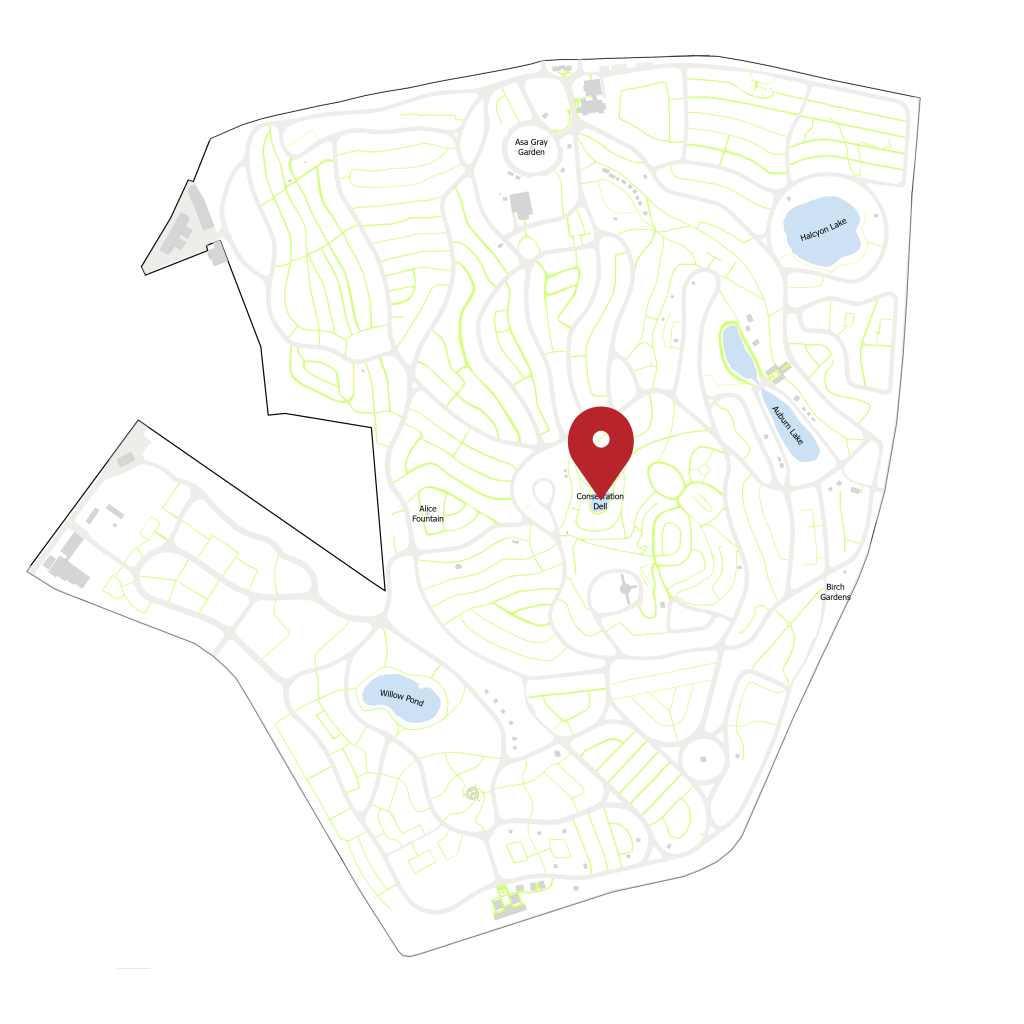
Consecration Dell is located in the center of Mount Auburn’s 175 acres. Walking paths leading into the Dell include Vine Path, Ivy Path, and Violet Path.
If you cannot visit in person, visit the Dell virtually.






Consecration Dell: Woodland Restoration
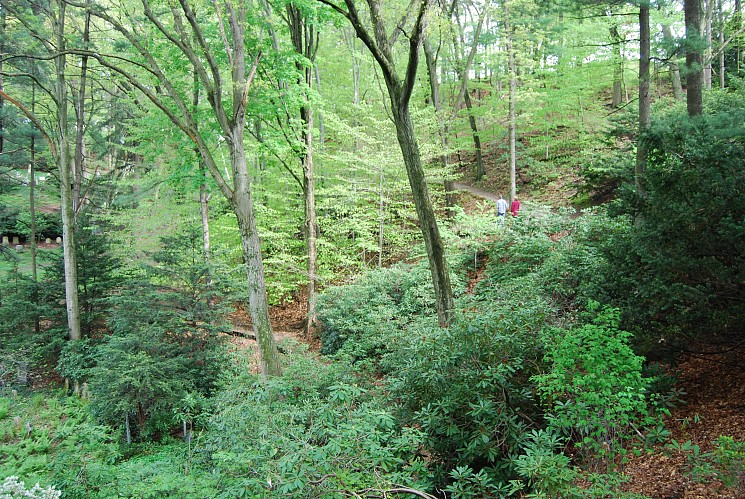
In his Consecration Address, Mount Auburn’s first president Joseph Story referenced the new Cemetery’s naturalistic qualities: “sheltered valley… silent grove… lofty oak… rustling pine… and the wildflower creeping along the narrow path.” Just three decades ago, little about the Dell resembled the woodsy and wild qualities Story had so eloquently described in 1831. In contrast to most other parts of Mount Auburn, the Cemetery had minimally managed Consecration Dell for more than a century. In that time, invasive Norway Maple trees became co-dominate with Red Oaks in the forest canopy. The invasive trees competed (and won) against the native vegetation leaving the forest floor largely bare.
By the end of the twentieth century, and as a product of its 1993 Master Plan, Mount Auburn developed new strategies to preserve, maintain, and enhance its historic landscape. For Consecration Dell, the last vestige of the original “rural cemetery,” this meant restoring a woodland that reflected Mount Auburn’s first decade when nature dominated art in the new Cemetery.
Today, visitors can experience Consecration Dell as a place both timeliness and very much of this time. The restored landscape that recalls Mount Auburn’s earliest years also reflects a modern approach to environmental stewardship. And, just as it has done for visitors throughout the eras, the Dell celebrates nature’s incredible power to console, heal, and inspire.
Restoring the Woodland
Following the Master Plan recommendations, Mount Auburn initiated work to restore the woodland in 1997. Over the next twenty years, this work continued one section at a time from the vernal pool in the Dell’s center to the surrounding slopes. The project’s early phases included removing Norway maples and other non-native species, such as Japanese yews and Japanese barberries. Thousands of native New England plants planted in their place established a new forest floor.
In addition to their historical appropriateness, these plants helped to reverse years of soil erosion. Plant roots help to anchor the soil in place below ground. Above ground, their foliage protects dry topsoil from being swept away by wind and breaks rainfall to prevent soil runoff. Because there was so little existing understory vegetation, this meant installing thousands of new plants at each stage of the project. Temporary irrigation allowed the plants to thrive, while regular weeding prevented Norway Maple seedlings from once again taking over. In some sections, the Cemetery injected plants into compost-filled burlap tubes pinned to Dell’s slopes. This strategy gave plants time to become firmly established on the slopes. The burlap since decomposed and the plants are now anchoring the soil independently.
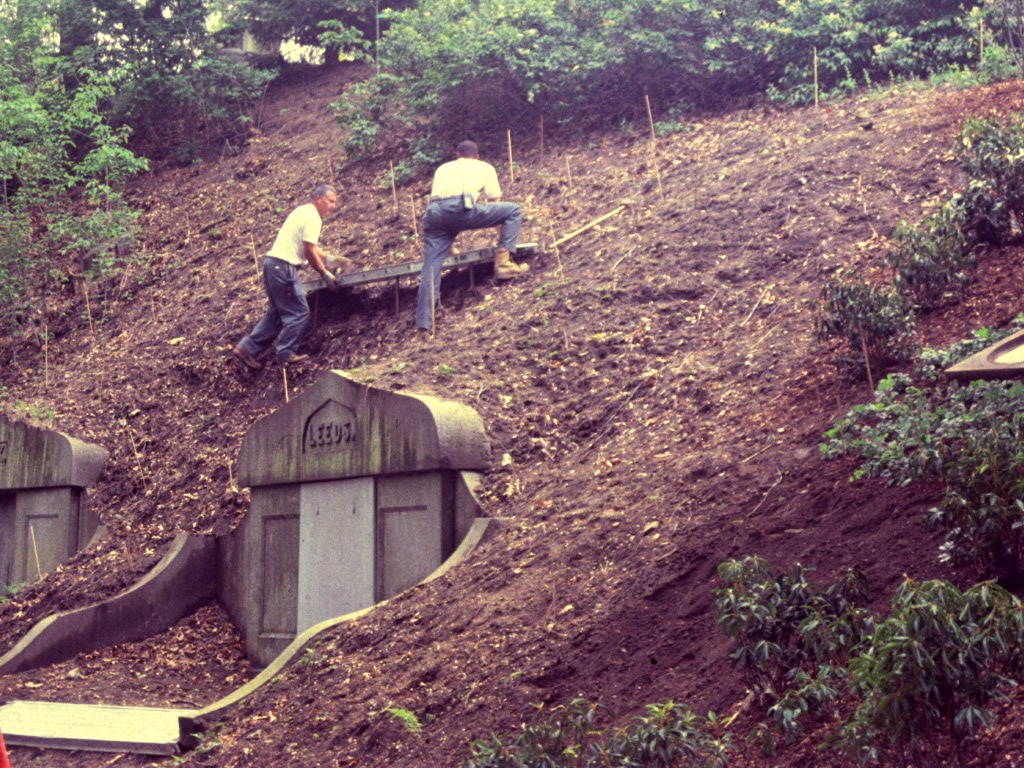
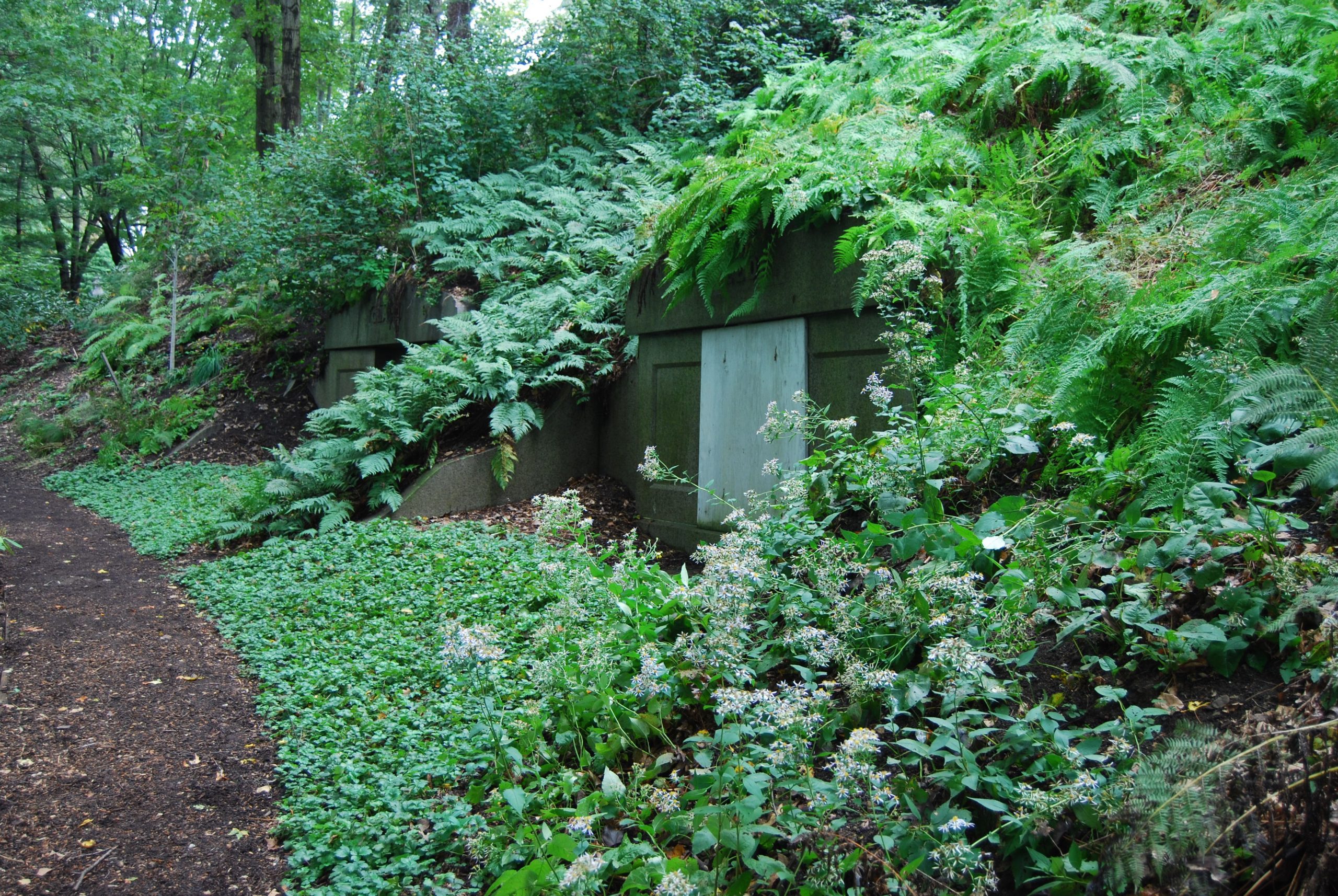
Years of trial-and-error field experience helped Mount Auburn further refine the list of appropriate plants for this area. Today, a healthy canopy of Red, Black, White, and Scarlet Oaks shelters a carpet of ferns (Hayscented Fern, Christmas Fern, and Lady Fern); herbaceous groundcovers and woodland wildflowers (White Baneberry, Wild Ginger, Mayapple, and American Spikenard); and shrubs (Winterberry, Rosebay Rhododendron, and Snowberry).
Habitat Improvements
As the Dell restoration progressed, the Cemetery’s horticultural practices were also evolving to consider wildlife habitat improvements. The Dell was (and is) ecologically significant in part because of a resident population of spotted salamanders that live beneath the leaf litter along the Dell’s slopes. Each spring, the salamanders emerge from the surrounding hills to breed in the vernal pool. From its inception, the project aimed to enhance the area aesthetically while also respecting the salamanders’ habitat requirements.
Over two decades of work, the goals of protecting and improving habitat expanded to address all wildlife’s needs. Though it hosted many birds, the Dell did not have the woodland understory vegetation necessary to constitute a “shrubland habitat” until more recent phases of the project addressed this specific need. Working with wildlife and horticulture experts, Mount Auburn curated a plant community that offers nesting materials, protection, and food sources for insects, amphibians, mammals, and birds. Consecration Dell is now the cornerstone of Mount Auburn’s comprehensive initiative to improve the natural vegetation and wildlife habitat throughout the Cemetery landscape.
A Dramatic Transformation
Far better than words, this series of photographs from the last few decades illustrate Consecration Dell’s dramatic transformation:
READ MORE

CONSECRATION DELL is the heart of Mount Auburn. Here, you can imagine history taking place, marvel at the beauty of nature, and find solace from the cares of the world in a woodland oasis.
ACKNOWLEDGEMENTS
The Consecration Dell Woodland Restoration Project has been made possible with generous support from the A.J. & M.D. Ruggiero Memorial Trust and other individual contributions to the Friends of Mount Auburn.
Eternally Green: Highlighting Mount Auburn’s Rich, Natural Environment Through Theatre
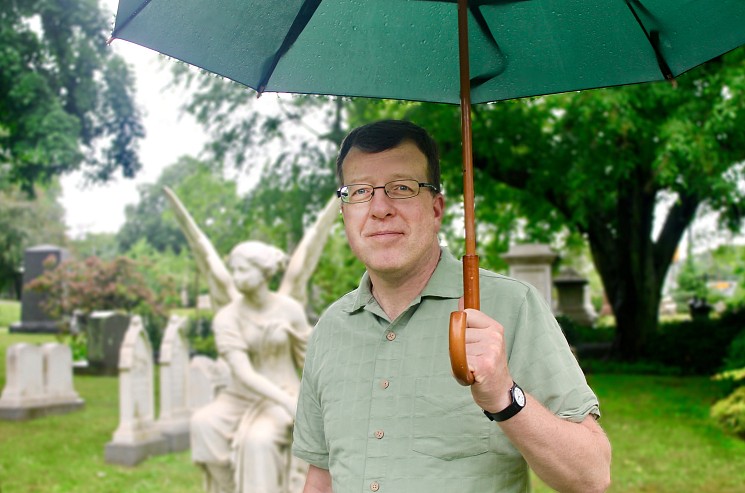
This article was written by Artist in Residence, Patrick Gabridge.
When I tell people I’m the artist-in-residence at Mount Auburn Cemetery, they are often shocked that such a thing exists and also very curious about what, as a playwright, I intend to do at a cemetery. Most folks assume I’ll be writing about the various people buried here. Which I will. But even from the very start of my residency this winter, I knew I wanted to write about the diverse and unique natural environment of Mount Auburn.
Since I started in January, I’ve been walking the grounds, toting binoculars with birders at dawn, looking for nighthawks at sunset on the tower, shining flashlights in Consecration Dell looking for spotted salamanders, and trying not to step on tiny toadlets by Halcyon Lake. And, more crucially for a playwright, I’ve been listening to the people who are deeply invested in protecting and improving the flora and fauna that make Mount Auburn such a special place.
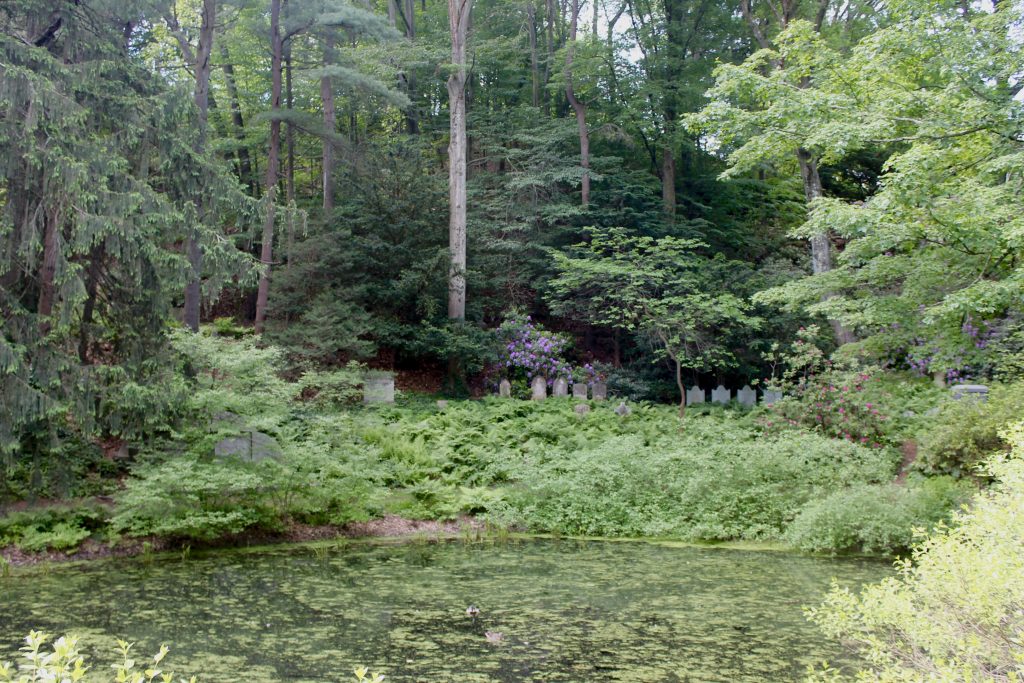
The challenge for a writer tasked with creating plays about Mount Auburn is the embarrassment of riches when it comes to potential stories. A hundred thousand tales are wrapped around the people interred here, and they are surrounded by hundreds of species of birds and trees, and thousands upon thousands of plants, all of them tended by dedicated stewards.
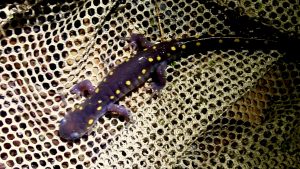
Spotted Salamander in Consecration Dell
In the end, I chose to create two series of short plays–one mostly about historical figures buried here and their role and relationship to the formation of American identity, and another set of nature plays. Some are already written and will be read on the grounds in September—like a short play called Hot Love in the Moonlight is about the mating habits of spotted salamanders. There will be a play about birds and birders (Cerulean Blue), and another about Asa Gray and Louis Agassiz. I’m still exploring play ideas around some of the secret mushroom spots that may or may not exist, and there will almost certainly be a play inspired by conversations with the grounds crew members who help Mount Auburn remain the gem that it is.
Beyond writing and research, the next step begins with reading and playing with the text with actors and audiences. This September, you will see me and Courtney O’Connor, my director, gathered with clumps of actors at Consecration Dell and near Auburn Lake, and other spots, with scripts in our hands, reading dialogue aloud. We’ll see if the structure and content of the work makes sense, if it has power, but also how it works in three-dimensions. How does it feel to have our voices and bodies in action on the actual grounds? It’s one thing for me to imagine how it all feels and sounds when I’m typing away in my office, but it’s entirely different when we have actors do it while standing on the edge of a pond.
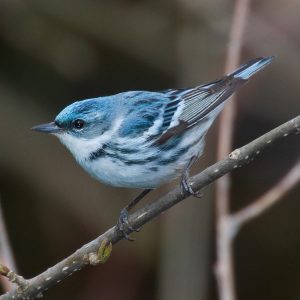
Cerulean Blue Warbler
At the public readings in September, we’ll start exploring what the plays feel like with an audience. (Plays are nothing without an audience.) When staging site-specific work there are additional concerns we don’t have in a traditional theatre, where the environment is controlled and well understood. We have to ask questions about where does the audience sit or stand, is there noise (traffic, neighbors) that will impact that site? How do the plants and topography affect where we can stand, how much sound reaches the audience, the visual palette? Entrances and exits are never simple when performing outdoors. How does the audience know when the show is over? And, in a cemetery, where do we perform such that we are respectful of the people who are buried here. How do we perform plays about nature, in nature, in ways that don’t harm the environment we’re talking about?
Having to answer all these questions, as we explore people and ideas in the text, is part of the challenge and fun of doing site-specific work. The other thing I truly love about this kind of theatre is that the barrier between the performers and audience is much more fluid and informal than in work created in a traditional spaces. The enormity and concreteness of the natural world around the very small play we’re creating helps unite the audience and performers.
In June of next year, we will fully stage the Nature Plays on the grounds, in a production that we hope will engage and delight audiences in all kinds of interesting ways. In the meantime, my team and I will be researching, writing, and playing, as we explore ways to illuminate the important natural elements of Mount Auburn Cemetery.
